old west
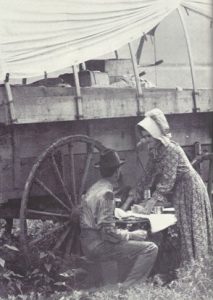 When we think of the Old West, the Pioneer movement, the Gold Rush, and generally, the settling of the United States, our minds immediately go to the brave men who fought the Indians, ran the wagon trains, weathered the harsh winters looking for their fortunes, and fought in the wars to make this a free nation, but seldom do we think of the anonymous heroes of that time…the women. There is a saying, “Behind every great man there’s a great woman.” that saying is one reference to the many women who have set aside their own comforts to support their man in the goals and dreams he has. In many ways that saying is the picture of the Pioneer woman, but it actually leaves something out. Just because her man did not become famous, doesn’t mean that the woman was any less behind him, supporting him in all he did.
When we think of the Old West, the Pioneer movement, the Gold Rush, and generally, the settling of the United States, our minds immediately go to the brave men who fought the Indians, ran the wagon trains, weathered the harsh winters looking for their fortunes, and fought in the wars to make this a free nation, but seldom do we think of the anonymous heroes of that time…the women. There is a saying, “Behind every great man there’s a great woman.” that saying is one reference to the many women who have set aside their own comforts to support their man in the goals and dreams he has. In many ways that saying is the picture of the Pioneer woman, but it actually leaves something out. Just because her man did not become famous, doesn’t mean that the woman was any less behind him, supporting him in all he did.
Pioneer women were there, on the home front, working hard all day trying to keep their house clean in a rugged windswept frontier. Her floors were often made of dirt, and yet she swept them. The water came from a well, or a nearby creek, and she had to haul it into the house, because her man was off hunting to bring in food for the family. The house was crudely constructed with logs and often had a sod roof, and she was right there working like a man beside her husband to get that house built. She watched over the children, and kept them safe from the many perils that were a daily encounter. From snakes, to bears, to mountain lions, to Indians, she did what she needed to, even to the point of handling a gun as well as her husband did. And yet, history looked at her as the weaker part of the partnership, the one who needed to be sheltered and protected. History looked at her as if she could not 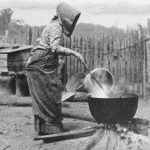 even bear to hear about certain things, because they might be too upsetting to her. In reality, they had vastly underestimated their women.
even bear to hear about certain things, because they might be too upsetting to her. In reality, they had vastly underestimated their women.
When the men got hurt, and the garden needed to be cared for, the women would till the ground…fighting with the tiller behind a horse, and winning the battle. These women took care of the house, the children, the sick or injured husband, and the garden or other crops, all without batting an eye. These women knew all about the hardships of frontier living, and when the going got tough, they didn’t turn and run back east. When the Indians attacked, they stayed and fought with their men. They could not afford to hide in a cellar, their hands were needed to hold a gun. They even faced the Indians alone, when their men were away, becoming excellent negotiators, who were able to make a trade of their wares that, in the end saved their own lives and the lives of their families. They were determined to make this new frontier work, and for the most part, they did it all without making a name for themselves. Sometimes, when we look up ancestors in historic archives, these women are either listed only as Mrs, acknowledging only the husband’s name, or they were listed only as the wife of their husband. Their true identity sometimes remains forever a mystery, and yet, they were heroes…but, they were anonymous heroes. The great men they stood behind, thereby making these men successful, may have been heroes of the frontier, and their name may have been one that every history book told us all about, 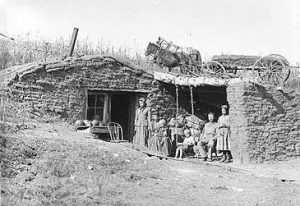 but their wives, who worked quietly beside them, remained unknown. We knew about the exploits of the men, the towns they founded, the travels they made exploring ever westward, but the women who were there with them, cooking the meals while the men talked, cleaning up afterward alone, delivering their babies often with only the help of their husband, carrying a baby, while weeding a garden, and feeding their family before themselves, going hungry, if necessary, to make sure the family was taken care of…these women rarely made the history books. Their job must have seemed to mundane to be considered adventurous, but without their contribution, this nation would not have become the great Republic that it is.
but their wives, who worked quietly beside them, remained unknown. We knew about the exploits of the men, the towns they founded, the travels they made exploring ever westward, but the women who were there with them, cooking the meals while the men talked, cleaning up afterward alone, delivering their babies often with only the help of their husband, carrying a baby, while weeding a garden, and feeding their family before themselves, going hungry, if necessary, to make sure the family was taken care of…these women rarely made the history books. Their job must have seemed to mundane to be considered adventurous, but without their contribution, this nation would not have become the great Republic that it is.
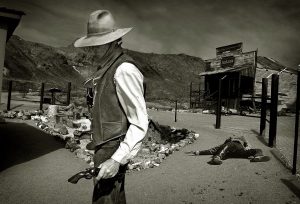 When we think of the outlaws of the old west, the term “gunfighter” or “gunslinger” were not the terms used to describe those men, or even the lawmen that some of them became upon changing their ways. They were actually originally called pistoleers, shootists, bad men, or one we do know…gunmen. That being said, Bat Masterson, who was a noted gunfighter himself, who later became a writer for the New York Morning Telegraph, sometimes referred to them as “gunfighters,” but, more often as “man killers.”
When we think of the outlaws of the old west, the term “gunfighter” or “gunslinger” were not the terms used to describe those men, or even the lawmen that some of them became upon changing their ways. They were actually originally called pistoleers, shootists, bad men, or one we do know…gunmen. That being said, Bat Masterson, who was a noted gunfighter himself, who later became a writer for the New York Morning Telegraph, sometimes referred to them as “gunfighters,” but, more often as “man killers.”
I suppose that Bat Masterson was probably the one who coined the term “gunfighter” in the first place, but many people from that era must have thought it an odd term to use. Still, if you heard an outlaw called a pistoleers, wouldn’t you have wondered what that was supposed to be? I would have, but then I would have looked it up and found that a pistoleers was “a soldier armed with a pistol.” That would have made no sense to me either, but in reality, some of the outlaws were soldiers who didn’t want to fight for a cause they didn’t believe in, so their deserted and headed west, so I guess they could have been pistoleers.
Another “movie mix-up” that happened is that in the old west, pistoleers or shootists didn’t squarely face off with each other from a distance in a dusty street, like they would like us to believe. In reality, the “real” gunfights of the Old West were rarely that “civilized.” Many fought in the many range wars and feuds of the Old West, which were far more common that the “stand-off” gunfight. Most of these were fought over land or water rights, some were political, and others were simply “old Hatfield-McCoy” style differences between families or in lifestyles. These people fought from the protection of anything available like a watering trough, a wall, building, or even a horse. Of those that more easily fit the perception of the “gunfighter,” you would find that they didn’t kill anywhere near the number of men they are credited with on television. In many instances their reputations stemmed from one particular fight, and the rumors grew from there, making people think they were that good. In other cases, self-promotion led people to believe they were lethal shootists, such was the case with Wyatt Earp and Wild Bill Hickok.
There were other, lesser known shootists, who actually saw just as much, if not more action than their well-known counterparts. Men like Ben Thompson, Tom Horn, Kid Curry, Timothy Courtright, King Fisher, Scott 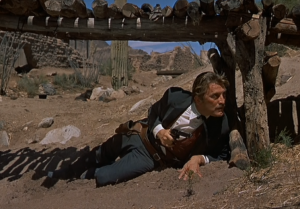 Cooley, Clay Allison, and Dallas Stoudenmire, just to name a few, were often not credited for nearly the shooting ability of the well known shooters. Often these gunfighters, whose occupations ranged from lawmen, to cowboys, ranchers, gamblers, farmers, teamsters, bounty hunters, and outlaws, were violent men who could move quickly from fighting one side of the law to the other, depending on what suited them best at the time. Though many of these gunman died of “natural causes,” many died violently in gunfights, lynchings, or legal executions. The average age of death was about 35. However, of those gunman who used their skills on the side of the law, they would persistently live longer lives than those that lived a life of crime.
Cooley, Clay Allison, and Dallas Stoudenmire, just to name a few, were often not credited for nearly the shooting ability of the well known shooters. Often these gunfighters, whose occupations ranged from lawmen, to cowboys, ranchers, gamblers, farmers, teamsters, bounty hunters, and outlaws, were violent men who could move quickly from fighting one side of the law to the other, depending on what suited them best at the time. Though many of these gunman died of “natural causes,” many died violently in gunfights, lynchings, or legal executions. The average age of death was about 35. However, of those gunman who used their skills on the side of the law, they would persistently live longer lives than those that lived a life of crime.
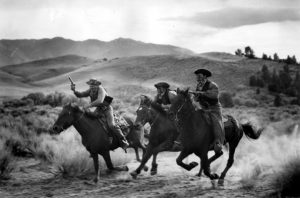 When a crime is committed, it seems to take forever to bring justice for the victims. Sometimes people just don’t want to wait, or they are so mad about the crime committed against them or their family, that they decide, either consciously or unconsciously, to take matters into their own hands. This is known as vigilante justice, and while we still have it today, it really was more prevalent in the Old West….at least as it applies to storming the jail and hanging the “criminal” accused of the crime, without a trial.
When a crime is committed, it seems to take forever to bring justice for the victims. Sometimes people just don’t want to wait, or they are so mad about the crime committed against them or their family, that they decide, either consciously or unconsciously, to take matters into their own hands. This is known as vigilante justice, and while we still have it today, it really was more prevalent in the Old West….at least as it applies to storming the jail and hanging the “criminal” accused of the crime, without a trial.
Vigilante justice was more common in the wild west days because law enforcement was almost non-existent. Vigilantes took it upon themselves to “enforce the law,” as well as their own moral code, even if the event was not necessarily against the law. When a mob would decide that a prisoner is guilty, they would storm the jailhouse, drag the prisoner out, down the street to a big tree, and there they would hang the prisoner, whether they were guilty or not. The mob had decided. I suppose that a lot of times the person who was hanged was guilty of the crime, but without a trial and evidence to prove their guilt, how could anyone be sure?
The term vigilante stems from the its Spanish equivalent, meaning private security agents, but the vigilantes of 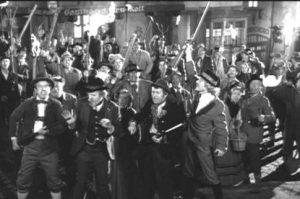 the old west and the mobs, who riot for their idea of right these days, have little in common with security agents. Most vigilantes and mobs are driven anger and adrenaline. Unfortunately those two things together don’t often bring a good outcome, and in the case of lynch mobs, it’s never a good outcome. Old West vigilantes were most common in mining communities, but were also known to exist in cow towns and in farming settlements. These groups usually formed before law and order existed in a new settlement. The justice dished out included whipping and banishment from the town, but more often, offenders were lynched. And sometimes the vigilante groups formed in places where lawmen did exist, but were thought to be weak, intimidated, or corrupt.
the old west and the mobs, who riot for their idea of right these days, have little in common with security agents. Most vigilantes and mobs are driven anger and adrenaline. Unfortunately those two things together don’t often bring a good outcome, and in the case of lynch mobs, it’s never a good outcome. Old West vigilantes were most common in mining communities, but were also known to exist in cow towns and in farming settlements. These groups usually formed before law and order existed in a new settlement. The justice dished out included whipping and banishment from the town, but more often, offenders were lynched. And sometimes the vigilante groups formed in places where lawmen did exist, but were thought to be weak, intimidated, or corrupt.
Some people see vigilantes as heroes, thereby giving them he support of some of the law-abiding citizens. Some people saw them as a necessary step to fill a much needed gap. Nevertheless, sometimes the vigilance committee began to wield too much power and became corrupt themselves. At other times, vigilantes were nothing more than ruthless mobs, attempting to take control away from authorities or masking themselves as “do-gooders” when their intents were little more than ruthless or they had criminal intent on their own minds. One of the first vigilante groups formed was the San Francisco Vigilantes of 1851. After several criminals were hanged the committee was disbanded. When the city administration, itself, became corrupt, a vigilante group formed once again in 1856. There were many vigilante groups formed in the American West. The Montana 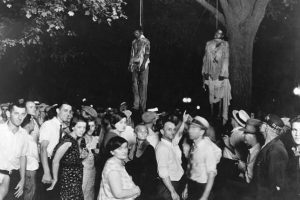 Vigilantes who hanged Bannack Sheriff Henry Plummer in 1864. They controlled the press, so the sheriff was made out to be the leader of an outlaw gang called the Innocents. Further investigation indicates that it might have been the vigilante group, themselves, who were behind the chaos reigning in Montana and that Henry Plummer was an innocent man. Following the Civil War, the Reno Gang began to terrorize the Midwest, resulting in the formation of the Southern Indiana Vigilance Committee. The next time the Reno Gang attempted to rob a train, a the vigilante group lynched its leaders…Frank, William and Simeon Reno. Vigilantes did good in some instances, but it was not really the best form of justice.
Vigilantes who hanged Bannack Sheriff Henry Plummer in 1864. They controlled the press, so the sheriff was made out to be the leader of an outlaw gang called the Innocents. Further investigation indicates that it might have been the vigilante group, themselves, who were behind the chaos reigning in Montana and that Henry Plummer was an innocent man. Following the Civil War, the Reno Gang began to terrorize the Midwest, resulting in the formation of the Southern Indiana Vigilance Committee. The next time the Reno Gang attempted to rob a train, a the vigilante group lynched its leaders…Frank, William and Simeon Reno. Vigilantes did good in some instances, but it was not really the best form of justice.
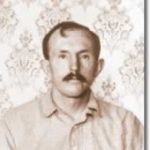 The old West as a wild place with very little law enforcement, and there was a lot of distance between lawmen. That also left room for may forms of lawlessness. I can’t say for sure that the gun for hire started in the old West, but it seems plausible. One such “gun for hire” was Thomas “Tom” Horn Jr, who often used the alias of James Hicks. Horn was born in Memphis, Missouri on November 21, 1860. He would become one of the most celebrated hired guns of the Old West, winning national fame for his freelance work, due in large part to his autobiography. Nevertheless, he wound up on the gallows for practicing his trade.
The old West as a wild place with very little law enforcement, and there was a lot of distance between lawmen. That also left room for may forms of lawlessness. I can’t say for sure that the gun for hire started in the old West, but it seems plausible. One such “gun for hire” was Thomas “Tom” Horn Jr, who often used the alias of James Hicks. Horn was born in Memphis, Missouri on November 21, 1860. He would become one of the most celebrated hired guns of the Old West, winning national fame for his freelance work, due in large part to his autobiography. Nevertheless, he wound up on the gallows for practicing his trade.
Tom was the fifth of 12 children, and his father, Tom Horn Sr, was a strict disciplinarian. Apparently, Tom didn’t like his dad’s strict ways, so he ran away in 1874 at the age of 14. Horn headed west…first to Santa Fe, then on to Arizona. By the time he was 15, he was an army scout and involved in many campaigns for more than a decade, including Geronimo’s surrender in 1886, in which Horn said he played a major role. During that time he also learned Spanish. As to his own account, Horn writing that he played a big role in the surrender of Geronimo, many historians doubt that, and actual accounts of that day indicate that Tom was there solely as a Spanish to English interpreter. After the surrender of Geronimo, Horn was discharged as a scout and reportedly mined for a while in Aravaipa, Arizona. Other than his autobiography, little is known about this period of his life for sure. We know that he was involved somehow with the Pleasant Valley War between Arizona cattlemen and sheepmen, but for which side is not clear.
It was during this time he decided to give law enforcement a try. In 1890, after proving himself during a short stint as a deputy sheriff in Arizona, Horn joined the Pinkerton Agency as a roving gunman, and using his gun with lethal effectiveness, tracked down dozens of outlaws, reputedly killing 17 men. He was pressured to resign by the agency, even though he was respected as a tracker. It seemed that with Horn came bad publicity. Horn decided to go it alone as a cattle detective, turning up in Wyoming in 1894 working for the beef barons. Horn denied killing anyone for the Pinkertons. Nevertheless, he was offering the same lethal services to the cattlemen, who were engulfed in what is known as the Johnson County War. As a “Stock Detective”, for each cattle rustler he shot, he charged $500-$600 and proved himself to be a methodical manhunter and ruthless killer. Horn once said “Killing men is my specialty. I look at it as a business proposition, and I think I have a corner on the market.”
After a short stint in Tampa, Florida working as a packer during the Spanish American War in 1898, Horn contacted Malaria and once mended, he headed back to Wyoming and returned to his dealings as a “gun for hire”. Records show that he was hired to stop cattle rustling in Brown’s Hole, Colorado in 1900, at which time he was going by the name James Hicks. He would boast in a letter, “I stopped cow stealing in one summer”, 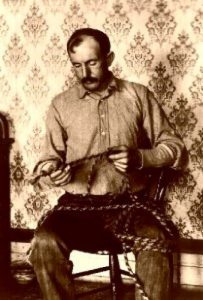 this being after he killed two area ranchers and scared the rest of the rustlers out of the area. In mid July, 1901, William Nickell, the 14 year old son of a sheep rancher, was ambushed and killed in the Iron Mountain region, allegedly due to a case of mistaken identity, as the bullet was meant for his father. About a week later, the boy’s father, Kels Nickell, was shot in the arm and hip during another ambush. U.S. Deputy Marshal Joe LeFors suspected Horn’s involvement. LeFors, wanting to gain a confession out of Horn, pretended to be in need of someone to take on a rustler clean up job in Montana. During this famous interview, Horn admitted to the Nickell’s shootings, not knowing that there was a court reporter hiding and taking notes. Ultimately, the interview would be his undoing. Although Horn alleged at his trial that he was drunk during the interview, he was found guilty on October 23, 1902, with the Wyoming State Supreme Court denying him a new trial. He was sentenced to hang, which was carried out in Cheyenne, Wyoming on November 20, 1903.
this being after he killed two area ranchers and scared the rest of the rustlers out of the area. In mid July, 1901, William Nickell, the 14 year old son of a sheep rancher, was ambushed and killed in the Iron Mountain region, allegedly due to a case of mistaken identity, as the bullet was meant for his father. About a week later, the boy’s father, Kels Nickell, was shot in the arm and hip during another ambush. U.S. Deputy Marshal Joe LeFors suspected Horn’s involvement. LeFors, wanting to gain a confession out of Horn, pretended to be in need of someone to take on a rustler clean up job in Montana. During this famous interview, Horn admitted to the Nickell’s shootings, not knowing that there was a court reporter hiding and taking notes. Ultimately, the interview would be his undoing. Although Horn alleged at his trial that he was drunk during the interview, he was found guilty on October 23, 1902, with the Wyoming State Supreme Court denying him a new trial. He was sentenced to hang, which was carried out in Cheyenne, Wyoming on November 20, 1903.
 Obscene language has not always been the norm where language is concerned, and in fact I don’t think most people talked that way even in the not so distant past of the Old West…certainly not in the way Hollywood would have us believe. Those were different times, and to hear the actors dropping the “f bomb” or the “s word” would be…almost laughable if it weren’t for the fact that it should be insulting. I’m not prudish, and I know that things have changed over the years, but when I hear someone cussing at their children, or using cuss words as, just another part of the conversation, I am sometimes shocked and offended. I don’t like to be one of those people who are offended by just everything, but perhaps if we were offended by obscene language, some of the much more shocking things that go on in our world wouldn’t be happening at all. When the Dick Van Dyke Show was on television, the couple had twin beds and the word pregnant couldn’t even be said on television. We all knew that most couples don’t have separate beds or separate rooms, but it went to show the more wholesome, clean cut, decent world we lived in then.
Obscene language has not always been the norm where language is concerned, and in fact I don’t think most people talked that way even in the not so distant past of the Old West…certainly not in the way Hollywood would have us believe. Those were different times, and to hear the actors dropping the “f bomb” or the “s word” would be…almost laughable if it weren’t for the fact that it should be insulting. I’m not prudish, and I know that things have changed over the years, but when I hear someone cussing at their children, or using cuss words as, just another part of the conversation, I am sometimes shocked and offended. I don’t like to be one of those people who are offended by just everything, but perhaps if we were offended by obscene language, some of the much more shocking things that go on in our world wouldn’t be happening at all. When the Dick Van Dyke Show was on television, the couple had twin beds and the word pregnant couldn’t even be said on television. We all knew that most couples don’t have separate beds or separate rooms, but it went to show the more wholesome, clean cut, decent world we lived in then.

By the 1920s, it seemed to begin to be understood that men, anyway, were going to use foul language at times, but they had better watch their mouth in front of the ladies, because it was a law that they not offend those ladylike ears with such harsh words. In fact, on October 8, 1921, a man was charged of speaking offensively in front of a lady and found guilty for using obscene language in front of a woman in Ohio. Now, if you could be fined or sent to spend a few days in jail for using foul language in front of a woman, I think people would be much more likely to watch their tongue. In my parents home, foul language would result in having your mouth washed out with soap. I guess that somehow Mom thought that would clean up the language, and in reality, it did. I don’t say that my sisters and I never used cuss words as teenagers, because everyone goes through rebellious times, but I can tell you that we did not do it in front of our parents, and our boyfriends were told that they had better not talk that way either, if they wanted to continue to date our parents daughter. Cussing was one of the fastest ways for a guy to get on the wrong side of our parents.
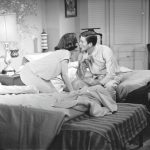
These days, it seems that everyone cusses, including children. I hear some of the things coming out of the mouths of little kids, and I almost can’t help having my jaw drop to the floor. Television shows consider some language as being acceptable, and then amazingly they bleep out other words that are not any worse than the ones they have allowed. Obscene gestures are the normal way to tell everyone in sight that you are not happy with what is going on around you, and screaming obscenities is the newest way to express your disgust. Some people have wondered if “swearing is a sign of a limited vocabulary” or is it just a way of “obscenitizing” our world. Either way I find that the loss of eloquent speech is very sad indeed.
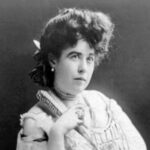 It’s strange…how often society prefers old money to new money. Maybe these days it’s not as common, but in the late 1800s, it was a little bit more common. That was the world Margaret Tobin grew up in. Who is Margaret Tobin, you might ask. Well, we didn’t really remember her as Margaret Tobin, but rather as Molly Brown…or more likely as The Unsinkable Molly Brown. That’s because on this day April 15, 1912, Molly Brown not only survived the sinking of the Titanic, but she heroically saved other people in the water, and kept the people in the lifeboat calm with her stories of life in the west.
It’s strange…how often society prefers old money to new money. Maybe these days it’s not as common, but in the late 1800s, it was a little bit more common. That was the world Margaret Tobin grew up in. Who is Margaret Tobin, you might ask. Well, we didn’t really remember her as Margaret Tobin, but rather as Molly Brown…or more likely as The Unsinkable Molly Brown. That’s because on this day April 15, 1912, Molly Brown not only survived the sinking of the Titanic, but she heroically saved other people in the water, and kept the people in the lifeboat calm with her stories of life in the west.
Molly was born the daughter of an impoverished ditch-digger. As a teenager, Molly went West to join her brother, who was working in the booming silver mining town of Leadville, Colorado. While there, the manager of a local silver mine, James J Brown, noticed her, and they fell in love. The couple married in 1886, and a short time later, James Brown discovered a large deposit of gold. They quickly became very wealthy. They moved to Denver, and tried unsuccessfully to take what should have been their rightful place in society, but the high society of the time…old money, just weren’t prepared to let these unstart, new money people with little social grooming into their ranks. Apparently Molly was a little too flamboyant for the stuffy, old money high society people. She was a little too much for her husband too, because they soon separated, and with her estranged husband’s financial support, Molly was able to live comfortably…for a time anyway…until most of the money ran out.
Molly left Denver and decided to travel. The Eastern elite, didn’t seem to mind Molly’s flamboyance, and soon accepted her as one of them. Socially prominent eastern families like the Astors and Vanderbilts prized her frank western manners and her thrilling stories of frontier life. It was her friendship with these people that brought her to the Titanic, on that fateful trip, but it was Molly herself and her heroic ways that brought her fame, even though 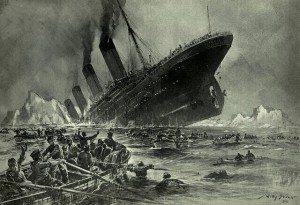 she obviously wasn’t the only woman who survived the sinking. After the ship hit an iceberg and began to sink, Brown was tossed into a lifeboat. She took command of the little boat and helped rescue a drowning sailor and other victims. To keep spirits up, she regaled the anxious survivors with stories of her life in the Old West. One the newspapers heard of her heroics, she gained national fame. She was dubbed “the unsinkable Mrs. Brown” and she became an international heroine. Before very long though, the money ran out, and she faded into obscurity, dying a woman of modest means in New York City in 1932. It was the Broadway musical that would revive her claim to fame, and change her title to The Unsinkable Molly Brown.
she obviously wasn’t the only woman who survived the sinking. After the ship hit an iceberg and began to sink, Brown was tossed into a lifeboat. She took command of the little boat and helped rescue a drowning sailor and other victims. To keep spirits up, she regaled the anxious survivors with stories of her life in the Old West. One the newspapers heard of her heroics, she gained national fame. She was dubbed “the unsinkable Mrs. Brown” and she became an international heroine. Before very long though, the money ran out, and she faded into obscurity, dying a woman of modest means in New York City in 1932. It was the Broadway musical that would revive her claim to fame, and change her title to The Unsinkable Molly Brown.
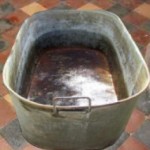
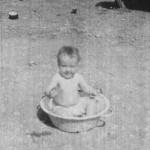 In the days before running water in homes, people had to go to river to bath, or bring water into the house from the river, creek, or well, and heat it on the stove so the family could bathe. Since families were usually large, the whole process took time, and heating water over and over again was not really feasible. What that meant was that the family pretty much all bathed in the same bath water. For the last guy, that had to be…well, disgusting, but that was the way it was done back in the old west, and even in more recent times when there was no running water in homes. For the little kids, however, I seriously doubt if it mattered. Getting wet was getting wet, and it really just didn’t matter what the water looked like…at least to the little boys. Girls might have felt differently. I think I would have.
In the days before running water in homes, people had to go to river to bath, or bring water into the house from the river, creek, or well, and heat it on the stove so the family could bathe. Since families were usually large, the whole process took time, and heating water over and over again was not really feasible. What that meant was that the family pretty much all bathed in the same bath water. For the last guy, that had to be…well, disgusting, but that was the way it was done back in the old west, and even in more recent times when there was no running water in homes. For the little kids, however, I seriously doubt if it mattered. Getting wet was getting wet, and it really just didn’t matter what the water looked like…at least to the little boys. Girls might have felt differently. I think I would have.
Personally, if I had a river or creek available, I think I would use that…in the summer anyway. Then again, there is very little privacy in a river or creek…and you can’t exactly put up a curtain around a river. I can’t really imagine how they lived that way exactly. I guess in that way I’m a modern girl, and don’t try to take my shower away from me. Maybe that’s why Bob and I don’t go camping…no running water, or if there is, it’s very inconvenient. As I have said before, I love hiking and being outdoors, but I like the modern conveniences of a hotel room afterward.
Of course, when homes got running water, bathing in an old tin bath tub went the way of all things old west. Nevertheless, for babies…it doesn’t matter if they are bathing or just playing in a bucket, pan, or clothes 
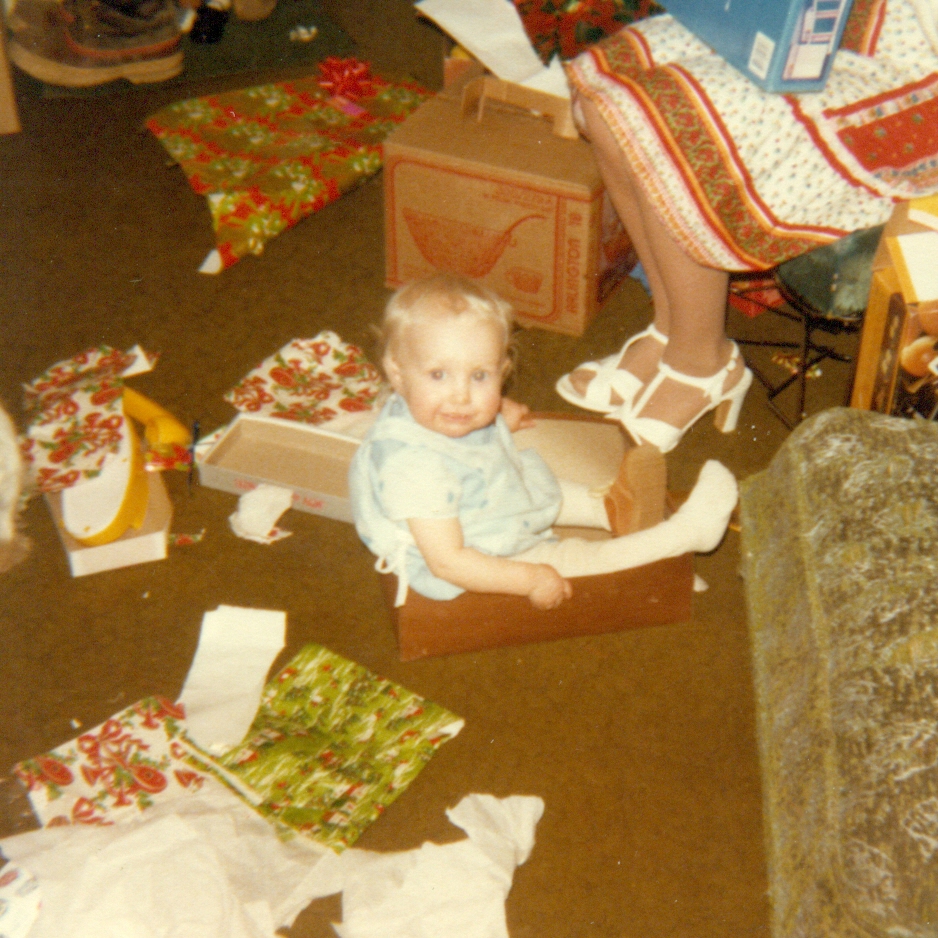 basket. Kids just like to play in them. I don’t think there is anything so amazing about that, like a throwback to the old west days of bathing in a barrel, but rather that kids just like finding different places to play. Things like an old box, barrel, or clothes basket are perfect. In that way, they remind me of cats. If you have ever watched a cat, you will find that they see a space, and if it looks fairly close to a good fit, in they dive. Babies tend to be that way too…but, the thing that is the funniest about that is when the baby tries to fit into a box that is seriously too small. Nevertheless, it’s a baby or cat thing.
basket. Kids just like to play in them. I don’t think there is anything so amazing about that, like a throwback to the old west days of bathing in a barrel, but rather that kids just like finding different places to play. Things like an old box, barrel, or clothes basket are perfect. In that way, they remind me of cats. If you have ever watched a cat, you will find that they see a space, and if it looks fairly close to a good fit, in they dive. Babies tend to be that way too…but, the thing that is the funniest about that is when the baby tries to fit into a box that is seriously too small. Nevertheless, it’s a baby or cat thing.
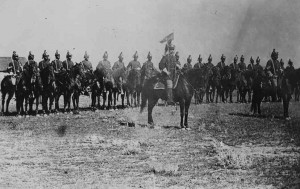 When I think of the Cavalry, I think of the Old West. The idea of men heading off to war mounted on horses, in today’s world seems completely crazy. In reality, it was precarious enough in the days of the Cowboys and Indians, but even more so with guided missiles, tanks, roadside bombs, and suitcase bombs…just to name a few. I realize that those weapons have evolved slowly, but the Cavalry probably rode horses well past the point when it was safe for them to do so. Nevertheless, the reality is that many of the men had no desire to give up their horse for the alternative in 1941, but that was what they were told to do, and so they did…many with tearful sadness to show for it. They followed their orders, with minimal grumbling, because things like that could get a guy in trouble. Still, the goodbyes were tearful, even if the tears had to be held until the soldier was alone.
When I think of the Cavalry, I think of the Old West. The idea of men heading off to war mounted on horses, in today’s world seems completely crazy. In reality, it was precarious enough in the days of the Cowboys and Indians, but even more so with guided missiles, tanks, roadside bombs, and suitcase bombs…just to name a few. I realize that those weapons have evolved slowly, but the Cavalry probably rode horses well past the point when it was safe for them to do so. Nevertheless, the reality is that many of the men had no desire to give up their horse for the alternative in 1941, but that was what they were told to do, and so they did…many with tearful sadness to show for it. They followed their orders, with minimal grumbling, because things like that could get a guy in trouble. Still, the goodbyes were tearful, even if the tears had to be held until the soldier was alone.
Of course, we know, as did they, that the weapons that were being lobbed at them were far more sophisticated than they had been in the early years, but they had come to trust their horse to get them out of the place that found themselves in. In reality, that was becoming harder and harder for the horse. Remember that any weapon that was lobbed at the rider, was also lobbed at the horse. It was hard to hit one and miss the other. A tank on the other hand was often invincible against many of the weapons back when the tank was invented. It was in the best interest of the soldier to give up his mount, but it was fully understood that it was also one of the hardest things they would ever have to do.
Troop F stationed at Douglas, Wyoming would be one of the last troops to be required to give up their horses. Their horses were stunning black Morgan horses, and this troop was proud of their horses, and their duties. One duty of which they were especially proud was when they escorted the Governor at state events. The riders were in their dress white uniforms, and even the horses were dressed up in white. The horses were so proud of their duties, and they knew them better than the rookies who were riding them. When the men presented their 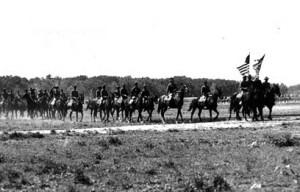 shining sabers, the horses would prance sideways in an elaborate display of discipline. For the men who worked with the beautiful horses daily, the thought of never mounting up again was…well, devastating.
shining sabers, the horses would prance sideways in an elaborate display of discipline. For the men who worked with the beautiful horses daily, the thought of never mounting up again was…well, devastating.
Nevertheless, in the end, the men lost their horses to the modern world and modern machines. While it was not the preferred situation, the men knew that times were changing and they would either have to change with the times, or become dinosaurs of the past. I suppose that most of them would continue on, because that is what soldiers do. They came to serve their country, and they would not let their final dismount be their final act in the service.
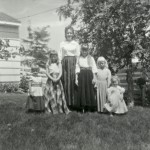 As kids growing up, my sisters and I were subjected to many stories, view, songs, and events that centered around the Old West. When I say subjected, I don’t mean that we hated every minute of I, because we didn’t. We lived in Wyoming, and therefore we embraced the Old West. I can’t say that my sisters and I always liked all things western, because that would be false too. We all went through our Rock and Roll era, and during that time, we pretty much hated Country music, although shows like Bonanza, the Rifleman, Wagon Train, and The Virginian…just to name a few, were among our favorites, and we each had our favorite actors, and we were going to “marry” them. I know, silly…right?
As kids growing up, my sisters and I were subjected to many stories, view, songs, and events that centered around the Old West. When I say subjected, I don’t mean that we hated every minute of I, because we didn’t. We lived in Wyoming, and therefore we embraced the Old West. I can’t say that my sisters and I always liked all things western, because that would be false too. We all went through our Rock and Roll era, and during that time, we pretty much hated Country music, although shows like Bonanza, the Rifleman, Wagon Train, and The Virginian…just to name a few, were among our favorites, and we each had our favorite actors, and we were going to “marry” them. I know, silly…right?
Back then, the Old West was still considered something that people were proud to know about, or even to know people who lived those times. It was the times that our grandparents grew up in, and that 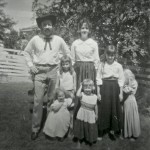 made it even more cool. I don’t suppose that the kids of today look back on the Old West or even the 1950s, 1960s, or 1970s, as being cool, because those times were before personal computers and cell phones, so I’m sure it seemed like the dark ages to the kids of today. Those years were probably best known for protests…unless you compare that era to today’s, when everyone is so offended by everything. Even when I look back on my childhood years, I can’t say that I think we as a generation did anything so amazing…at least not until we grew up, because of course, it is our generation that invented the computer and cell phone. Nevertheless, it was a vastly different era that the Old West…or maybe that’s just my opinion.
made it even more cool. I don’t suppose that the kids of today look back on the Old West or even the 1950s, 1960s, or 1970s, as being cool, because those times were before personal computers and cell phones, so I’m sure it seemed like the dark ages to the kids of today. Those years were probably best known for protests…unless you compare that era to today’s, when everyone is so offended by everything. Even when I look back on my childhood years, I can’t say that I think we as a generation did anything so amazing…at least not until we grew up, because of course, it is our generation that invented the computer and cell phone. Nevertheless, it was a vastly different era that the Old West…or maybe that’s just my opinion.
While we were little, many of the cities and states were celebrating their centennial years, and it was a big deal!! Contests were held to see who could grow the best beard, and I’m sure who had the best Old Western costume. My Dad, Allen Spencer, decided to grow a beard for the competition. I don’t know if he won or not, or even if he entered any contest at all, but he got in on the festivities…as did Dad’s girls. We each had a long dress, much like the women of the Old West wore, and our parents took pictures to document the events. It was a great time, and they made sure that they had plenty of pictures of it.
These days, you seldom hear of such events. I don’t know if states or cities are 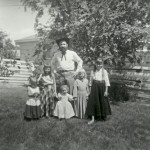 just not at the right point, or if many people have just lost interest, or what has happened exactly, but you don’t see these things happening. I find that sad, because our family found it to be very fun and interesting. Of course, there are still reinactments of old western robberies, the pony express, and wagons west trips, and I think those would be fun, but for some reason that centennial just seemed different…more interesting somehow…like we were a real pioneer family.
just not at the right point, or if many people have just lost interest, or what has happened exactly, but you don’t see these things happening. I find that sad, because our family found it to be very fun and interesting. Of course, there are still reinactments of old western robberies, the pony express, and wagons west trips, and I think those would be fun, but for some reason that centennial just seemed different…more interesting somehow…like we were a real pioneer family.
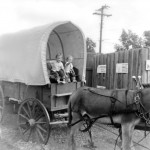 Over the years of our childhood, my sisters and I were exposed to the history of this great nation. Mom and Dad loved the things that showcased the Old West, including Country Music, old western movies, and western books, but they mostly wanted to show us the places where the Old West really happened. Of course, some of the places were replicas of the real thing, such as Wall Drug. Any time we went through South Dakota and there was enough time, we stopped at Wall Drug. It’s funny to think that a drug store could be called a tourist attraction, but with all the wagons, horse statues, and photo boards, people come just to see the sights in the drug store. Wall Drug is in the town of Wall, South Dakota…a huge town of 906 people…and that is today, so I’m sure it was much smaller when I was a little girl. In fact, I don’t recall anything about the town of Wall…just the drug store. I suppose that sounds funny, but the drug store really was the coolest place in town.
Over the years of our childhood, my sisters and I were exposed to the history of this great nation. Mom and Dad loved the things that showcased the Old West, including Country Music, old western movies, and western books, but they mostly wanted to show us the places where the Old West really happened. Of course, some of the places were replicas of the real thing, such as Wall Drug. Any time we went through South Dakota and there was enough time, we stopped at Wall Drug. It’s funny to think that a drug store could be called a tourist attraction, but with all the wagons, horse statues, and photo boards, people come just to see the sights in the drug store. Wall Drug is in the town of Wall, South Dakota…a huge town of 906 people…and that is today, so I’m sure it was much smaller when I was a little girl. In fact, I don’t recall anything about the town of Wall…just the drug store. I suppose that sounds funny, but the drug store really was the coolest place in town.
Of course, when Mom and Dad took us to see relics of the old West, they would take us to places like an old 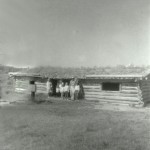 fort, which inevitably included an old cabin with a sod roof. People these day, have no idea how that worked…unless they had parents who made sure that they got to see a real one. Even when you study about it in school, there is nothing quite like being able to see what it was really like inside a house with dirt and grass for a roof. I have read books like, “Young Pioneers” and the “Little House On The Prairie” books, that talk about having a sod roof, or even a Soddy, which is a house built out of sod, often into a hillside. The floors were obviously dirt, and the homemaker would actually sweep those dirt floors. As I read about that, I began to wonder if those women weren’t just a little bit crazy, but then again, I suppose that if you left the crumbs in the house, you would have more bugs than normal, because I personally don’t see any way to have a sod home be completely bug free. And of course, depending on what got spilled, the floor could take on a sticky life of its own. After thinking about that for a little while, I think I might consider sweeping that dirt floor too.
fort, which inevitably included an old cabin with a sod roof. People these day, have no idea how that worked…unless they had parents who made sure that they got to see a real one. Even when you study about it in school, there is nothing quite like being able to see what it was really like inside a house with dirt and grass for a roof. I have read books like, “Young Pioneers” and the “Little House On The Prairie” books, that talk about having a sod roof, or even a Soddy, which is a house built out of sod, often into a hillside. The floors were obviously dirt, and the homemaker would actually sweep those dirt floors. As I read about that, I began to wonder if those women weren’t just a little bit crazy, but then again, I suppose that if you left the crumbs in the house, you would have more bugs than normal, because I personally don’t see any way to have a sod home be completely bug free. And of course, depending on what got spilled, the floor could take on a sticky life of its own. After thinking about that for a little while, I think I might consider sweeping that dirt floor too.
When I think about it though, what would the Old West be, without horses. I can’t say that I ever gave any 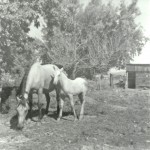 thought to having horses of my own, but I think horses are awesome, if someone else has to clean up the stalls. There were people that Mom and Dad knew, who had horses, and they might have been family members for all I know. Having friends or family who had horses made it possible for us to have a little bit of exposure to horses and how they were. I can’t imagine having to travel everywhere by horse, but riding one is a lot of fun. I feel like our parents gave my sisters and me vacations combined with education. Mom and Dad always made it feel like we were really there in the Old West. It was like going back in time. It was an education that you couldn’t get in school, and while I was no fan of history in school, I must say that history as my parents taught it to us, was an amazing journey.
thought to having horses of my own, but I think horses are awesome, if someone else has to clean up the stalls. There were people that Mom and Dad knew, who had horses, and they might have been family members for all I know. Having friends or family who had horses made it possible for us to have a little bit of exposure to horses and how they were. I can’t imagine having to travel everywhere by horse, but riding one is a lot of fun. I feel like our parents gave my sisters and me vacations combined with education. Mom and Dad always made it feel like we were really there in the Old West. It was like going back in time. It was an education that you couldn’t get in school, and while I was no fan of history in school, I must say that history as my parents taught it to us, was an amazing journey.

